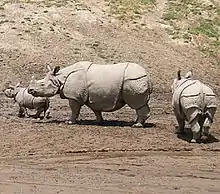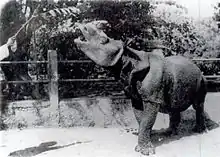Rhinoceros (genus)
Rhinoceros is a genus comprising one-horned rhinoceroses. This scientific name was proposed by Carl Linnaeus in 1758.[1] The genus contains two species, the Indian rhinoceros (Rhinoceros unicornis) and the Javan rhinoceros (Rhinoceros sondaicus). Although both members are endangered, the Javan rhinoceros is one of the most endangered large mammals in the world with only 60 individuals surviving in Java (Indonesia). A fossil jawbone of an extinct species, Rhinoceros philippinensis, was found in the Philippines. The word 'rhinoceros' is of Greek origin meaning "nose-horn".
| Rhinoceros | |
|---|---|
 | |
| Indian rhinoceros (R. unicornis) | |
 | |
| Javan rhinoceros (R. sondaicus) | |
| Scientific classification | |
| Kingdom: | Animalia |
| Phylum: | Chordata |
| Class: | Mammalia |
| Order: | Perissodactyla |
| Family: | Rhinocerotidae |
| Tribe: | Rhinocerotini |
| Genus: | Rhinoceros Linnaeus, 1758 |
| Species | |
Classification
The genus Rhinoceros comprises:
- Indian rhinoceros (R. unicornis) Linnaeus, 1758[1]
- Javan rhinoceros (R. sondaicus) Desmarest, 1822[2]
- †R. hemitoxhus
- †R. leptorhinus[3]
- †R. philippinensis described by von Koenigswald in 1956 were fossil remains found in Cagayan province of the Philippines.[4]
- †R. platyrhinus Falconer and Cautley 1847 syn Punjabitherium Khan (1971) Upper Siwaliks, Early Pleistocene to early Middle Pleistocene, India. Largest species in the genus[5]
- †R. sinensis[6] wastebasket taxon[7] used to refer to rhinoceros material from the Pleistocene of China, various specimens belong to other Rhinoceros species, Dicerorhinus and Stephanorhinus.[8]
Etymology
The genus name Rhinoceros is a combination of the ancient Greek words ῥίς (ris) meaning 'nose' and κέρας (keras) meaning 'horn of an animal'.[9][10]
References
- Linnæus, C. (1758). "Rhinoceros unicornis". Caroli Linnæi Systema naturæ per regna tria naturæ, secundum classes, ordines, genera, species, cum characteribus, differentiis, synonymis, locis. Holmiae: Salvius. p. 56.
- Desmarest, A. G. (1822). "Rhinocéros des Îles de La Sonde". Mammalogie, ou, Description des espèces de mammifères. 2. Paris: Mme Agasse. pp. 399–400.
- Brandt, J. F. (1877). "Versuch einer Monographie der Tichorhinen Nashörner nebst Bemerkungen über Rhinoсеrоs leptorhinus. Cuv. U. S. W." Мémoires l'académie impériale des sciences de St.-Pétersbourg 7 série, tome 24, number 4.
- von Koenigswald, G. H. R. (1956). "Fossil mammals from the Philippines". Proceedings of the Fourth Far-Eastern Prehistory and the Anthropology Division of the 8th Pacific Science Congresses Combined. Part 1: Prehistory, Archaeology and Physical Anthropology (Second Fascicle, Section 1): 339–369.
- Pandolfi, Luca; Maiorino, Leonardo (2016-02-06). "Reassessment of the largest Pleistocene rhinocerotine Rhinoceros platyrhinus (Mammalia, Rhinocerotidae) from the Upper Siwaliks (Siwalik Hills, India)" (PDF). Journal of Vertebrate Paleontology. 36 (2): e1071266. doi:10.1080/02724634.2015.1071266. ISSN 0272-4634.
- Schepartz, L. A.; Miller-Antonio, S. (2010). "Taphonomy, life history, and human exploitation of Rhinoceros sinensis at the Middle Pleistocene site of Panxian Dadong, Guizhou, China". International Journal of Osteoarchaeology. 20 (3): 253–268. doi:10.1002/oa.1025.
- Antoine, Pierre-Olivier (March 2012). "Pleistocene and Holocene rhinocerotids (Mammalia, Perissodactyla) from the Indochinese Peninsula". Comptes Rendus Palevol. 11 (2–3): 159–168. doi:10.1016/j.crpv.2011.03.002.
- Tong, Hao-wen (November 2012). "Evolution of the non-Coelodonta dicerorhine lineage in China". Comptes Rendus Palevol. 11 (8): 555–562. doi:10.1016/j.crpv.2012.06.002.
- Liddell, H. G. & Scott, R. (1940). "ῥίς". A Greek-English Lexicon (Revised and augmented ed.). Oxford: Clarendon Press.
- Liddell, H. G. & Scott, R. (1940). "κέρᾳ". A Greek-English Lexicon (Revised and augmented ed.). Oxford: Clarendon Press.
External links
| Wikimedia Commons has media related to Rhinoceros. |
| Wikispecies has information related to Rhinoceros. |